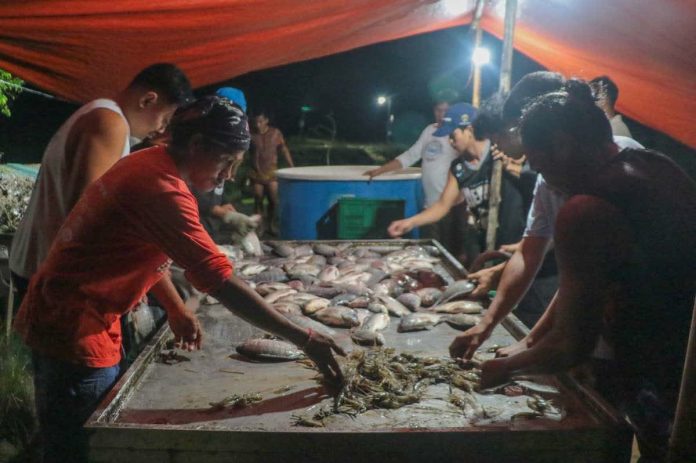
FARMING tilapia is profitable. Raising giant freshwater prawn or “ulang” is, too. But what happens when you grow them together? They don’t just share a pond, but they multiply profits.
In Barangay Nanga, Pototan, Iloilo, a project led by SEAFDEC/AQD recently harvested 2.9 tons of tilapia and 167 kilograms of giant freshwater prawn on September 30, demonstrating how pairing the two species can mean higher yield and better income for local farmers.
The initiative used a polyculture system, where complementary aquaculture species are grown in the same compartments at the same time to maximize space and yield.
Fed primarily with tilapia feeds, the harvested tilapia averaged 500 grams, and the prawns about 20 grams.
The 1,000-square-meter ponds were stocked on April 29 with tilapia fingerlings from the Provincial Agriculture Office and giant freshwater prawn fry from SEAFDEC/AQD’s Tigbauan Main Station. Pond 12 contained 6,000 tilapia and 9,000 prawns, while Pond 16 had 6,000 tilapia and 15,000 prawns.
The experiment-demonstration was conducted at the freshwater ponds of the Provincial Agri-Aqua Research and Technology (ART) Center and is part of the SEAFDEC/AQD’s “Grow-out Polyculture of Nile Tilapia and Giant Freshwater Prawn” project under the Joint Mission for Accelerated Nationwide Technology Transfer Program (JMANTTP).
A perfect pond relationship
The two species are an ideal match for polyculture because their feeding habits and pond behaviors naturally complement each other.
Tilapia feed near the surface and mid-water on algae and floating pellets, while the prawns, as bottom dwellers, consume leftover feed and organic matter that settle on the pond floor.
As tilapia move through the waters, they stir up sediments and improve oxygen circulation, which creates conditions favorable for prawn growth. In turn, the prawns clean the pond bottom, minimize waste buildup, and help maintain good water quality.
Since tilapia and the freshwater prawns occupy different pond zones and consume different kinds of food, they don’t have to compete over what to eat. This enables them to thrive well in a shared environment.
Although not symbiotic, their relationship is ecologically compatible, where each benefits indirectly from the other’s activity without depending on it for survival.
This method of farming not only maximizes pond use but reduces risks associated with single-species farming.
“Through this collaboration, we’re turning our Department’s science-based aquaculture technologies into practical, field-tested, and adoptable solutions that can help farmers improve their production and income,” said SEAFDEC/AQD Chief Dan Baliao.
Another success
On the same day, the monoculture trial of giant freshwater prawn in a 1,500-square-meter pond, stocked at 26 prawns per square meter, produced 604 kilograms after 4.5 months of culture using commercial vannamei feeds.
Both trials were funded under JMANTTP and jointly implemented by SEAFDEC/AQD, BFAR Region 6, and the Iloilo Provincial Government’s Office of the Provincial Agriculture, with SEAFDEC/AQD providing technical expertise and supervision throughout the grow-out period.
So, tilapia or ulang? Why choose one when you can farm both? (Nyra Armada)/PN







